


| Enigmai | 
|
 |
 |
 |
 |
 |
 |
 |
Breed Standard of the Cavalier King Charles Spaniel
Way back in 2008 the Kennel Club requested that we remove our verbatim reproduction of the breed standard from our website 'in case it might change'. At the time you would have got a mere 12,700 search 'hits' from Google alone detailing the exact same verbatim reproduction ~ as of this evening this has risen to Google ~ "About 3,170,000 results", whilst Bing gives 440,000 results!!! Why they singled us out I do not know, but be that as it may for a no frills version they would like you to follow this link to the Kennel Club CKCS Breed Standard page (which is the same as we used to have) but if any changes are made to the 1986 standard (as reviewed fourteen years ago in December 2007) then this is where they will be ~ https://www.thekennelclub.org.uk/breed-standards/toy/cavalier-king-charles-spaniel/. Whilst the descriptor page has not changed in many a year it can be useful to follow the link to get up to speed on any current health issues that might crop up over and above the known CKCS ones.
Therefore to help prospective owners and those with a genuine interest understand the standard we have gone to a fair few of the aforementioned Google hits and what we have tried to do is show the best translation of the Breed Standard, not only into English (I'm a firm believer in the Plain English Movement (even though my Irish ancestry shows through sometimes)), but also to try and demonstrate it pictorially below using suitable pictures of our girls past and present. We think they are perfect - but we're biased, as is every breeder and/or owner - and judges come to that. I must stress that the quotes are from a number of these numerous sites and not the KC site, after all that is copyrighted and 'cannot be copied' ~ even though it blatantly is on millions of sites!
The original Breed Standard was written in 1928 based primarily on a dog named Ann's Son, a common ancestor for all Cavalier King Charles Spaniels. Anyway, this limited standard was revised in 1948 to a version not dissimilar to the one that has been in use for the last 70 odd years. So here goes with our translation/interpretation of the present standard.
The Standard Description
General Appearance ~ Active, graceful and well balanced, with gentle expression.
Characteristics ~ ~ Sporting, affectionate, absolutely fearless.
Temperament ~ Gay, friendly, non-aggressive; no tendency to nervousness.
Translation ~ In general a Cavalier is a very affectionate, loving and friendly dog. Always active, unless you and they feel otherwise (they do like to sleep in the sun) but you try and get out of the door without a four-footed friend appearing as if by magic at your feet waiting for their walk! Graceful and well balanced when they move and as Sasha proved many times - absolutely fearless. Generally the male dog is 'beefier' than the female in such a way that he looks more masculine, whilst the female should be prettier to look at and more feminine.
It is because they have such a gentle temperament and are so friendly and non-aggressive that Cavaliers are sometimes used as part of a therapy regime for stroke patients and are great companions for the elderly and infirm as they love to be stroked.
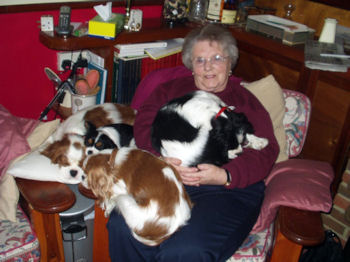
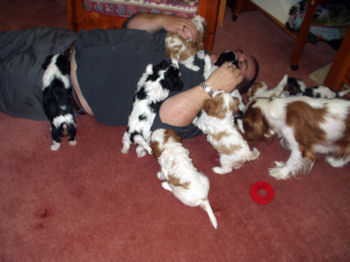
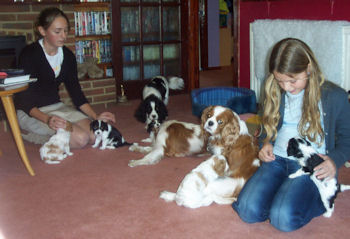
The Head and Skull
Skull & Stop
The skull should be almost flat between the ears.
Translation ~ Ideally you do not want a dead flat skull, neither do you want a very pronounced domed skull.
The dog should have a nice shallow stop and ideally the distance from the base of the stop to tip of nose should be about 1½ inches.
Translation ~ The stop is the division between the eyes and the muzzle and this is the part that should be a shallow curve (not perpendicular) and from here to the tip of the nose should be as close as possible to the desired 1½ inches.
Nostrils & Mouth
Their nostrils should be completely black and well developed and preferably without flesh marks.
Translation ~ It is not unusual for young dogs and puppies to have pink, flesh coloured patches around their nostrils. Normally these will disappear with age and amazingly the hormone change in pregnant bitches also helps it to disappear - this is only a 'problem' when showing the dog - it has ABSOLUTELY no detrimental effect on the dog!
They should have a well tapered muzzle with lips that are well developed but not pendulous and a well-filled face below the eyes.
Translation ~ The muzzle should be nicely tapered and not wide and short whilst the lips should also be nicely formed and not like a bloodhounds. The area of the face below the eyes should have a nice cushioning which gives that 'soft' look to a Cavaliers face. If there is insufficient cushioning in this area it gives what is described as 'snipiness'
Eyes & Ears
With large, dark and round eyes (but not prominent) which should be spaced well apart.
Translation ~ The preference would seem to be for a very dark brown colour to the eyes which gives that 'loving look', whilst a deep black or yellowy/light brown colour give a 'harder' look to the face. The eyes should also be round rather than almond shaped or small and 'piggy', and not set too close together.
Their ears should be long and set high on the head, with plenty of feather.
Translation ~ a Cavalier has long ears covered by long, silky hair. The fleshy part is known as the leather and should reach to about the level of the mouth. The long hair on the ears should obviously be longer (longer is better) and should not be trimmed. The set of the ears refers to their placement on the head - too high and the dog has a very surprised look, whilst too low and too much emphasis is placed on the curved part of the skull making it look domed.
Jaw & Neck
The jaws should be strong with a perfect, regular and complete scissor bite, i.e. the upper teeth closely overlapping the lower teeth.
Translation ~ It is only since the Breed Standard revision of 1986 that a perfect scissor bite has been required and is one whereby the top set of teeth just extend past the lower set and closely overlap them. If the lower jaw extends further than the upper jaw this is known as an undershot jaw, whilst the opposite is known as an overshot jaw.
The neck should be slightly arched when viewed from the side and of a moderate length running into well laid back shoulders.
Translation ~ Running from the base of the skull to just in front of the withers (shoulder area) the neck should be 'elegantly' arched and clearly visible. (If the neck is too short the dog will look like a body builder on steroids!) The lower neck should be smooth and not hang down whilst the upper neck should 'flow' into a level back. A good approximation I have read is that the back is roughly 3½ times the neck length.

Sasha
Willow
Ziva
The Main Body and Legs
Body
The back should be nice and level whilst the body should be short-coupled with a good spring of rib.
Translation - This means that the distance between the last rib and the hip should be relatively short compared to the total body length and the ribs should be seen to form a definite curve as they leave the back - but not like a barrel. The back should ideally be nicely level and neither dipped in the middle nor arched (roach back), this applies whether the dog is standing still or moving.
Forequarters
Moderate chest and nicely straight legs which should be moderately boned.
Translation - The front should be neither too wide in proportion to the dogs size nor too narrow - hence 'moderate chest' - this gives plenty of space for the heart and lungs. In much the same way the leg bones should be firm and graceful and nicely straight with the feet also pointed forwards - neither 'toeing out' nor 'out at elbows'.
Hindquarters
Legs should be moderately boned with a well turned stifle - no tendency to cow hock or sickle hocks.
Translation - The stifle joint is the joint where the femur meets the tibia and fibula from the lower leg at the knee joint (patella). This joint should make a 90° angle - hence 'well turned stifle'. 'Cow hocks' is where the lower part of the rear legs toes out at a distinctive angle, whilst 'sickle hocked' is the opposite effect and the lower leg bows in.
Coat
The coat should be long and silky with plenty of feathering. Totally free from trimming.
Translation ~ It can take 18 months or more for a dogs coat to develop to its full 'potential' and with the advent of the summer months a dog will lose a lot of its fur (moult). We notice it more with our girls because every time they have a season they moult, and when they have had a litter....
Another strange phenomenon is that generally the longer between a bitches seasons the more luxurious and feathered their coat is.
Sometimes you will occasionally get a 'throwback' with a wiry coat but a Cavalier has a very soft coat and unless somebody is a very adept hairdresser the temptation to trim the straggly bits usually stands out pretty well.
Another point that prospective owners should bear in mind is that, when speyed/neutered the coat will then become thick and wiry and quite often have a greasy feel to it caused by the ensuing hormone imbalance. We have noticed this with all our girls who have been speyed ~ to such a degree that Jade had to go to the groomers every six to nine months to keep her coat under control.
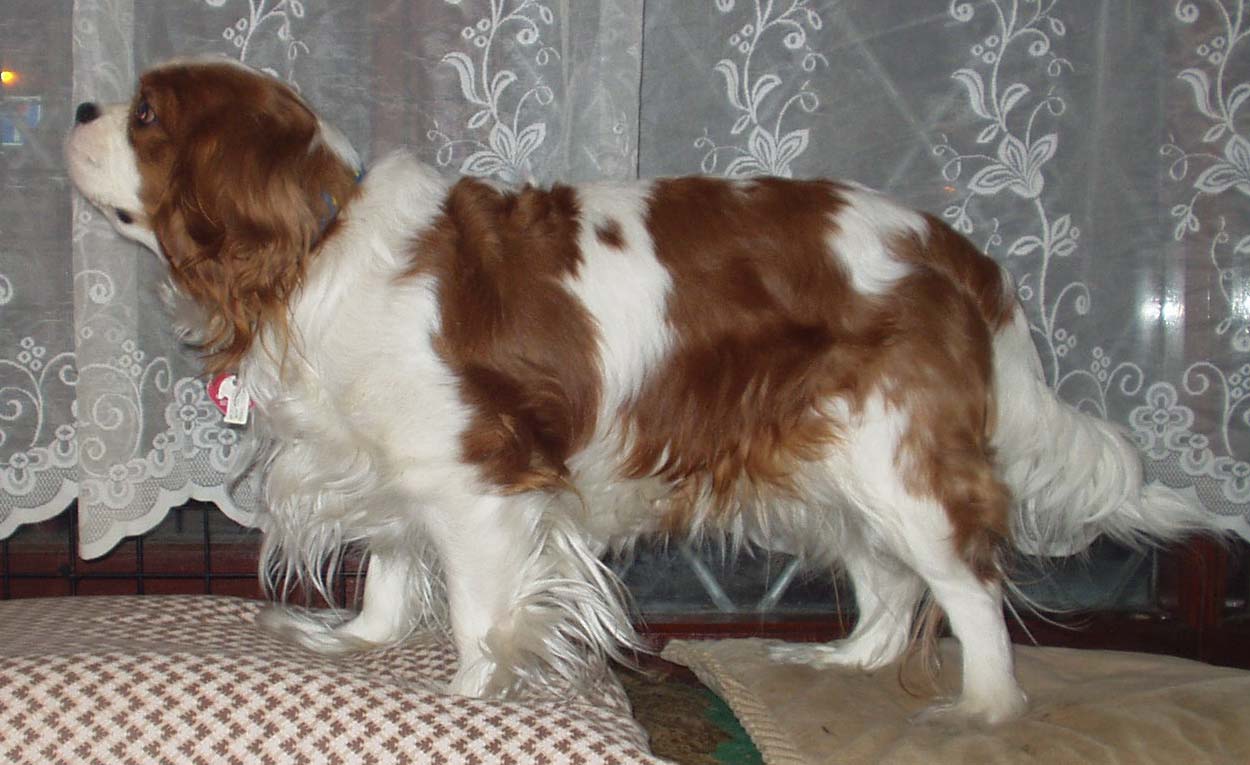
Amber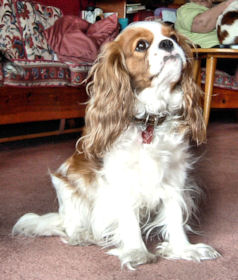
Heidi
Feet and 'other bits'
Feet
Compact, cushioned and well feathered.
Translation ~ a Cavaliers foot should be nicely rounded and the pads on the underside of the foot should be firm but well cushioned. If the dog is only exercised in the back garden, on grass or in the house it is in danger of becoming flat-footed. To maintain a firm, compact foot ensure that the dog gets a good amount of walking on roads/footpaths or hard earth paths. You can see a good example of well feathered feet on Lucy below. Only trim the hair in between the pads if it is causing a health problem or has grown so thick that the dog is finding it hard to walk - never trim the main feathering on the foot.
Tail
Length of tail in balance with body, well set on, carried happily but never much above the level of the back. Docking previously optional when no more than one third was allowed to be removed.
Translation - As the tail is a continuation of the backbone, the back and tail should form a smooth join and the length should be proportionate to the dogs overall body length. As with human physiognomy, the get-out clause is never much above the level..., one can only strive for as close as possible. Most Cavaliers will hold their tail slightly above back level when they are happy and vice versa when being disciplined.
As for docking - well, in our opinion docking a Cavaliers tail for anything other than medical reasons is an abhorrent practice and quite rightly frowned upon. Definitely something that should have been dropped from the Breed Standard years ago
Gait
Free moving and elegant in action, plenty of drive from behind. Fore and hind legs move parallel when viewed from in front and behind.
Translation - It has to be said that the Cavalier is one of the more elegant dogs when walking and a well proportioned dog will move smoothly with its head and neck held proud and the tail constantly wagging horizontally as it walks.
Whilst also pushing forward under the body, the pads of the rear legs should be visible from behind giving the breed standard 'drive'. The parallelness of the legs is self-explanatory but actually refers to when the dog is moving - not static.
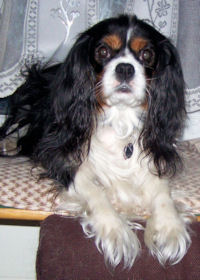 Lucy |  Jade |
Colours
Cavalier colourings fall into two groups - Wholecolours and Particolours. The confusing bit for those new to the breed is that both Ruby and Black & Tan are classed as wholecolours whilst Blenheims and Tricolours are classed as particolours. See I told you it was confusing, where else but the animal/human world would two colours equate to one ~ truth be told its more a case of those on the left have white in their coat whilst those on the right don't! Be that as it may you should only ever find three colours in the Cavalier breed ~ pearly white, rich chestnut red and raven black and it is the combinations of these three colours that make the four 'flavours'.
Blenheim:
(Heidi, Amber & Abbie)
By far the most prominent and popular of the four permutations, the Blenheim has rich chestnut red markings over a white background. The chestnut markings should have plenty of white between ~ this gives the breed standard of well broken up; The chestnut colouring should include the ears and the sides of the face, the more evenly divided on the head the better, with a band of white up the middle of the face and widening over the crown of the head leaving room for that much valued lozenge mark or spot which is a unique characteristic of the breed. NOT an essential requirement, there have been many very successful Cavaliers without it. If you look at pictures of Amber side-on you will notice that in a couple of places she has tiny brown markings in the white on her sides, this is known a ticking. No detrimental mention is made in the KC Breed Standard about this but the 'purist' breeder/owner will prefer not to have these 'extra' markings. WHY?
Tricolour:
(Sasha, Lucy, Willow & Ziva)
Probably the second most popular of the colourings the Tricolour has deep raven black patches on a white background - but - it must have those rich tan markings over the eyes (Like a pair of eyebrows), on the cheeks, inside the ears and under the tail. As Sasha proved also prone to 'ticking' ~ usually black ticking on the white flanks.
Black & Tan:
(Jade & Crystal)
With most of the body that lovely raven black the Black & Tan also has the rich tan markings over the eyes , on the cheeks, inside the ears and under the tail, but also has them on the chest and the legs . Any white is considered detrimental to the colouring - NOT the dog, and it is not unknown to get 'throwbacks' with white in them, often the feet.
Ruby:
(Katie)
The only TRUE wholecolour of the breed, a Ruby is a deep, rich red all over. Occasionally some Ruby's will have slightly paler front and backs, but this is not considered detrimental in the show ring whilst again white is.
Quote ~ Any other colour or combination of colours "most undesirable" ~ End quote
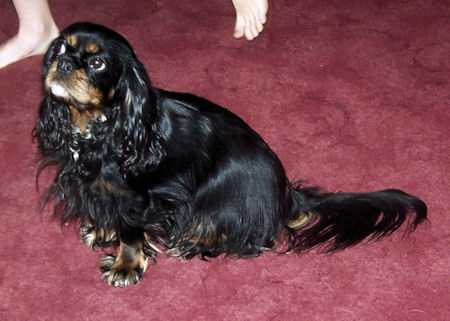 Crystal | 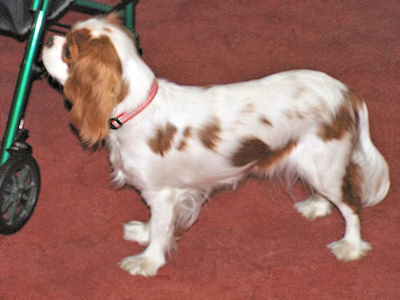 Abbie |
Weight & Size
Weight - 12 to 18 pounds (5.5 to 8.2 kilograms). A small well-balanced dog within these weights is desirable, especially for showing, but a dog which carries a bit more weight well, i.e. no fat is acceptable. For example if we were to attempt to get Amber down to even the top weight limit we would have the RSPCA et al having serious issue with us about malnutrition!
It is also sad to say that, in spite of the Breed Standard specifically stating that the breed should be shown in its natural, untrimmed state (other than medical reasons) you can attend many shows where the use of scissors and curling tongs have been blatantly used. What makes it more frustrating is the fact that show judges then award such 'doctored' animals placings - one of the main reasons we seldom frustrate ourselves by attending shows other than the Southern CKCS Limited Shows.
The decree/Act Of Parliament by Charles II entitling King Charles Spaniels to enter any building (including shops and the Houses of Parliament!) has NEVER been repealed!! This is the only breed that is entitled to do so BUT in spite of the similarity it does not apply to this breed. This is a Cavalier King Charles Spaniel different shaped head, mouth, feet, etc. To see the difference go to Cavaliers.co.uk where it is explained in greater detail with pictures.
Reviewed:~ Feb 2024